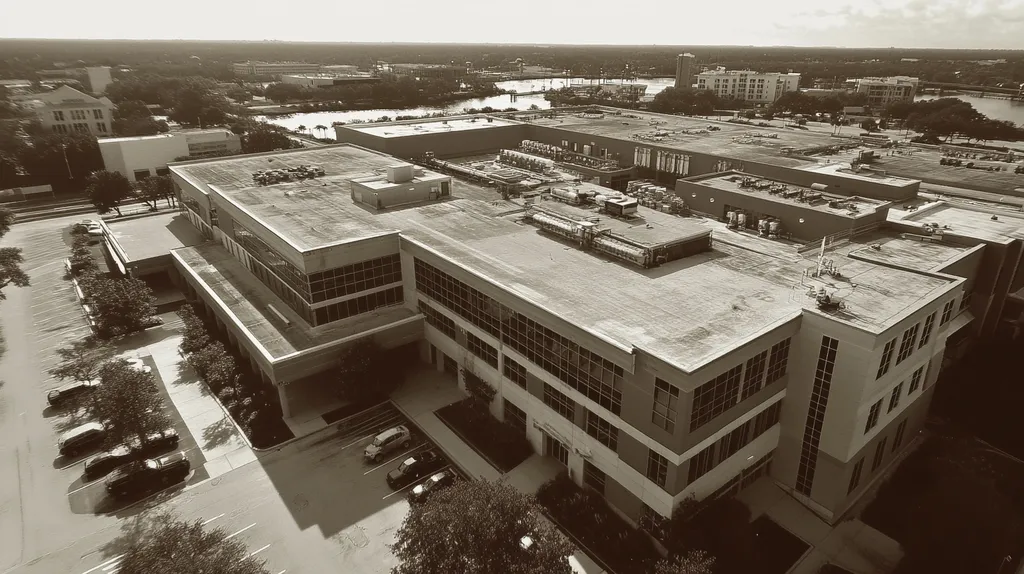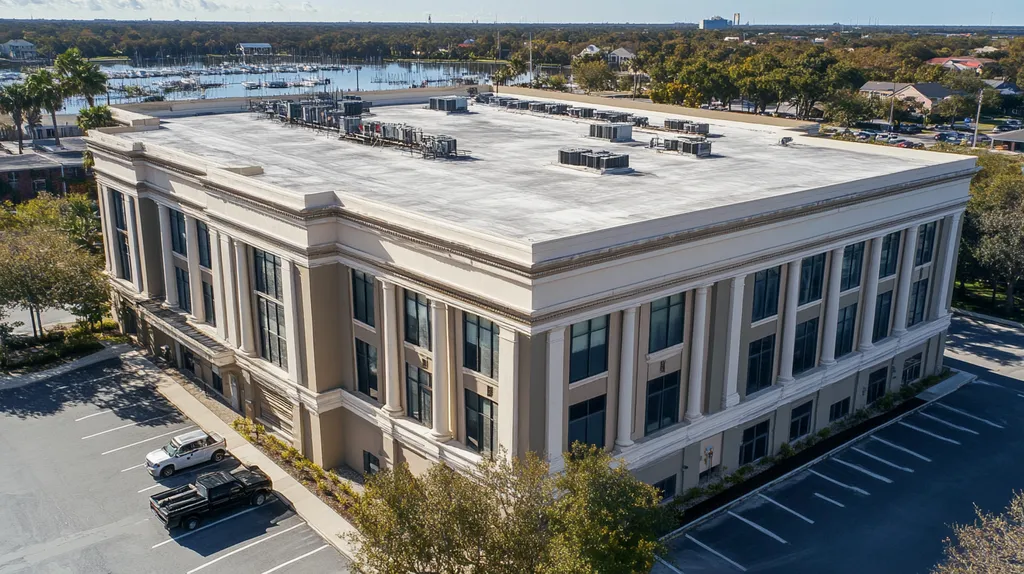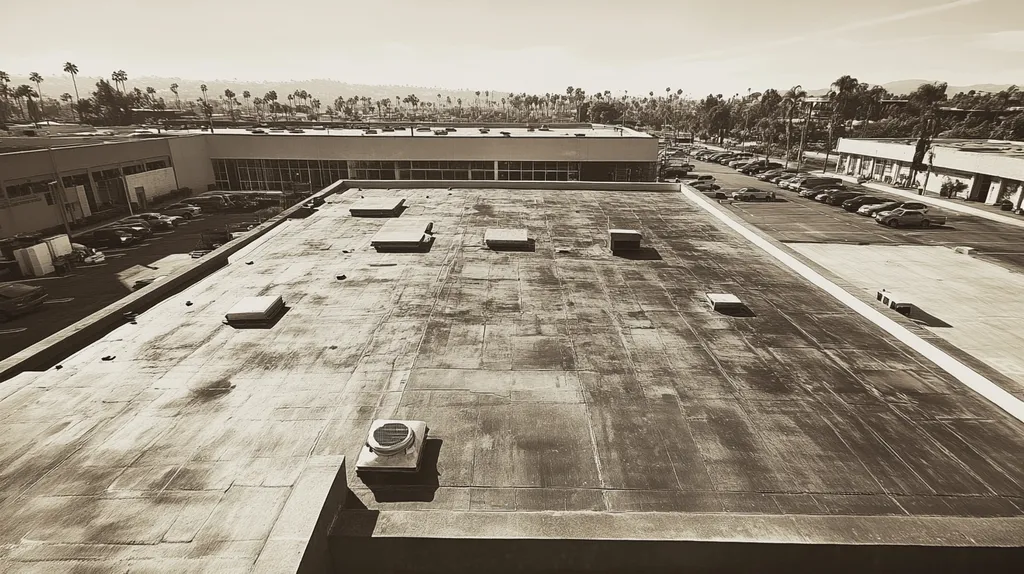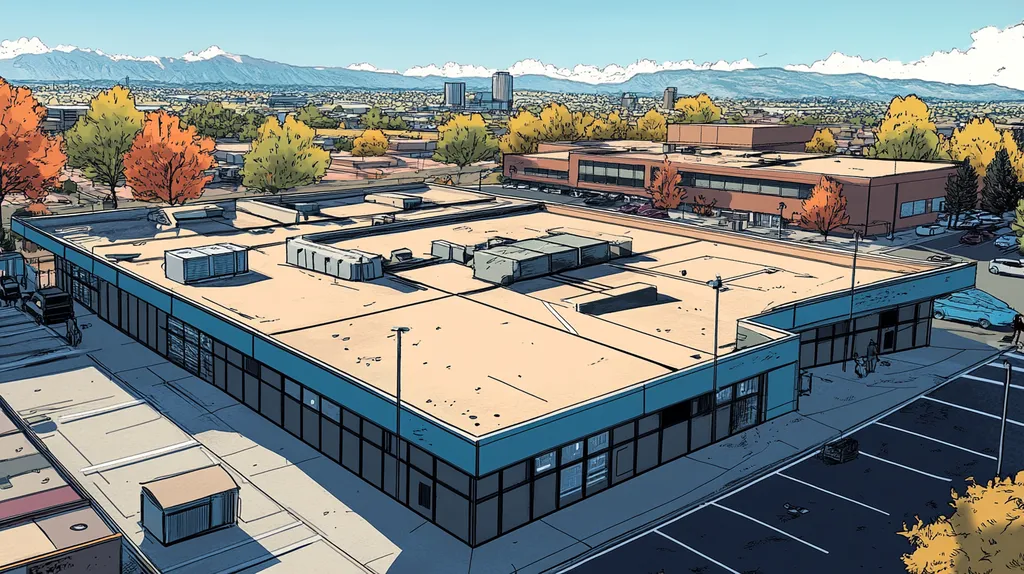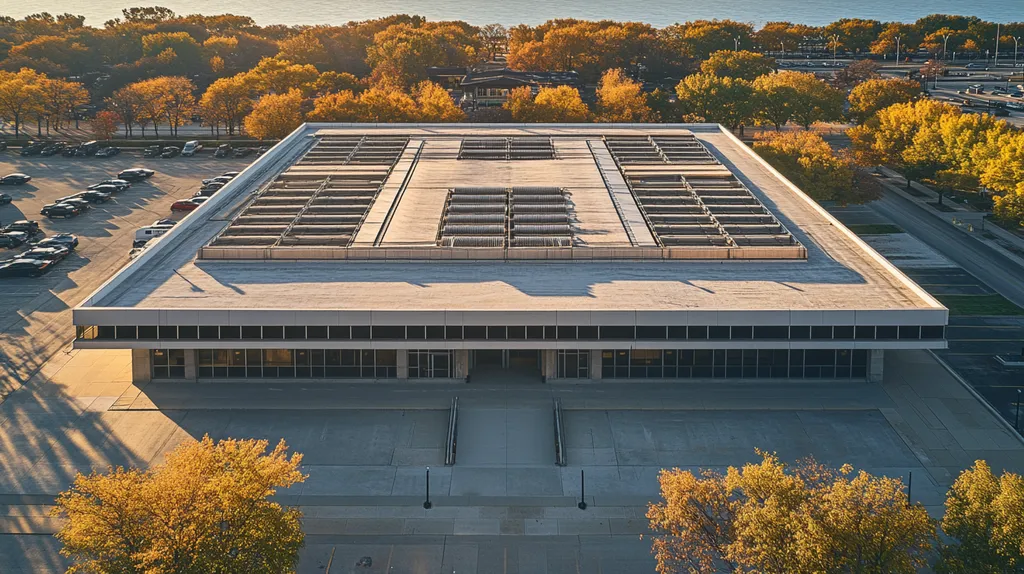In the face of increasingly extreme weather events, industrial facilities across North America are discovering a harsh reality: up to 40% of commercial roofs are inadequately protected against stormwater runoff, leading to millions in annual damage.
The growing complexity of roofing coatings, combined with stricter environmental regulations, has created an urgent need to separate fact from fiction in stormwater management.
This comprehensive analysis examines common misconceptions about industrial roof coatings, explores their practical implications, and provides evidence-based solutions for property owners seeking to protect their investments while meeting environmental compliance standards.
SECTION 1: COMMON MISCONCEPTIONS
In the realm of industrial roofing coatings, misconceptions are more than just misunderstandings; they can jeopardize property investments and stormwater management efforts. Alarmingly, studies reveal that about 40% of commercial buildings encounter premature roof failures due to ill-suited coatings. It’s essential to grasp these misconceptions to foster better decisions that yield long-term benefits. This section delves into three widespread myths that can misguide roofing strategies for property owners.
Myth: All Roof Coatings Are Created Equal
A pervasive belief is that all roof coatings are interchangeable. While they may share a surface appearance, the reality is starkly different: the effectiveness of a roofing coating can vary significantly based on its materials. For example, acrylic coatings provide excellent UV resistance, while silicone coatings stand out for their waterproof properties.
The implications for stormwater management are critical. Choosing the wrong coating can escalate runoff and create serious drainage issues. Reflective coatings, for instance, reduce heat absorption, helping to maintain a stable rooftop environment, whereas non-reflective options may intensify thermal expansion and contraction, leading to further complications.
Property owners should invest time in researching the specific advantages associated with each coating type. An ill-informed choice might not only result in diminished performance but also pave the way for costly repairs. Examining product data sheets and seeking guidance from seasoned professionals can clarify the essential differences.
In short, not all roof coatings are fit for every application. A customized approach is necessary to maximize stormwater management and ensure roof longevity. An informed understanding of product characteristics will empower property owners to make choices that benefit their buildings and budgets.
Misunderstanding Roof Material Impact on Stormwater
Another critical misconception is the notion that roofing materials have minimal influence on stormwater management. In truth, the type of roofing directly affects how rainwater is managed during and after storms. For instance, while asphalt roofs absorb heat, they often create higher runoff volumes due to their impermeable nature.
On the flip side, green roofs and porous materials significantly minimize stormwater runoff. These alternatives can absorb rainwater, allowing for a gradual release into drainage systems and reducing the risk of flooding. However, it is important to note that such systems require diligent maintenance to fully realize their benefits.
A well-chosen roofing material tailored to the local climate and specific property needs is paramount. Gaining insight into how different materials interact with stormwater can lead to more strategic investments. Property owners should reach out to roofing professionals to evaluate which materials are best suited to their unique circumstances.
Ultimately, the decision around roofing materials extends beyond mere aesthetics; it plays a crucial role in crafting effective stormwater management strategies. Knowledgeable choices can enhance both building performance and environmental stewardship.
Ignoring Maintenance in Roof Coating Effectiveness
Maintenance is frequently undervalued when assessing roofing coatings, leading to significant long-term issues. Many property owners mistakenly believe that once a coating is applied, their roofing concerns are resolved. In reality, routine inspections and maintenance are indispensable for preserving the integrity of an applied coating.
Neglecting maintenance can shorten the lifespan of the roof and undermine its stormwater management capabilities. For example, accumulation of debris can clog drainage systems, resulting in water pooling and an increased likelihood of leaks. Regular maintenance allows for early detection of such problems before they escalate.
Moreover, some coatings may require reapplication after several years to maintain their protective qualities. It’s vital to understand the specific maintenance needs associated with each coating type for sustained performance.
In closing, overlooking maintenance can entirely defeat the purpose of applying a roof coating. Recognizing its vital role enables property owners to protect their investments more effectively and enhance stormwater management outcomes.
SECTION 2: PRACTICAL IMPLICATIONS
Understanding the implications of industrial roofing coatings is more crucial than ever. As stormwater runoff regulations tighten, property owners must recognize the potential liabilities associated with their roofing choices. Research reveals that urban areas derive as much as 85% of their runoff from rooftops, highlighting a pressing need to scrutinize roofing materials and coatings for their environmental impact.
Metal Roofs and Leaching of Zinc and Copper
Metal roofs are favored for their durability and long lifespan, yet they come with environmental concerns. One notable issue is the leaching of zinc and copper into stormwater, which can occur when rain washes these metals from the roof surface. Studies indicate that such leaching can lead to harmful concentrations in nearby water bodies.
This environmental impact not only threatens aquatic ecosystems but may also put facility managers at risk of regulatory scrutiny. Areas abundant with metal roofs have seen troubling trends in stormwater quality, prompting local authorities to enforce stricter compliance measures.
To mitigate these risks, selecting the right coatings is essential. Some coatings function as barriers, effectively reducing metal leaching and protecting surrounding waterways.
When considering roofing solutions, it’s vital to evaluate how different materials interact with stormwater. By opting for compliant roofing systems, property owners can avoid potential fines while contributing to environmental preservation.
Chemical Treatments for Moss and Algae Growth
Moss and algae growth on roofs present more than just cosmetic issues; they can compromise a roof’s integrity and affect water quality. To combat these growths, facility managers often resort to chemical treatments, but the repercussions of these choices extend into the stormwater system.
Many chemical treatments contain substances that may wash off during rainfall, leading to contamination of stormwater. This can result in nutrient loading in local waterways, contributing to harmful algal blooms and overall water quality degradation.
To address this issue sustainably, facility managers should explore eco-friendly alternatives. Options like green roofing solutions or specialized coatings can dramatically reduce or even eliminate the need for harmful chemicals in treating moss and algae.
Investing in these preventative measures not only maintains a roof’s appearance but also plays a significant role in meeting environmental compliance and safeguarding long-term building health.
Impact of Roof Coatings on Water Quality
The type of roof coating chosen has a profound effect on stormwater quality. Many conventional coatings are synthetic or petroleum-based, and they can leach harmful chemicals into the environment, posing risks to stormwater systems and the surrounding ecosystems.
Research shows that employing water-based, low volatile organic compound (VOC) coatings can substantially enhance stormwater quality. Facility managers should weigh the full lifecycle impacts of their roofing choices, considering both environmental outcomes and potential cost savings.
Utilizing innovative coating solutions not only boosts roof longevity but also improves the quality of water runoff, keeping in line with stricter environmental regulations.
Choosing eco-friendly coatings is a proactive step that aligns with sustainability goals, protecting community resources while minimizing liabilities for property owners.
SECTION 3: COST OF MISINFORMATION
The stakes surrounding industrial roofing coatings are high, particularly when misinformation abounds. According to the National Roofing Contractors Association, neglecting proper roof maintenance can result in repair costs reaching an alarming 15% of a building’s total value. This section will explore the financial impacts of misleading information about roof coatings, highlighting immediate expenses as well as hidden long-term implications like regulatory penalties and decreased property values.
Financial Consequences of Poor Roof Maintenance
Ignoring roof maintenance can result in unexpected financial set-backs. As roof conditions deteriorate, they often require expensive repairs or even total replacements. Just one small leak can snowball into significant damage, leading to hazardous mold growth and threatening the structural integrity of the building, resulting in potential expenses that may reach tens of thousands of dollars.
Conversely, regular maintenance is typically a fraction of these potential repair costs. Property owners who overlook routine inspections are inviting trouble. Investing in suitable roof coatings can extend the roof’s life and ease future maintenance burdens.
Moreover, many property managers fail to allocate funds for potential repairs, crippling their financial strategies. This oversight can redirect budget resources away from other critical building needs. By prioritizing proactive maintenance, property owners can streamline their financial operations.
Ultimately, the long-term financial ramifications of neglect directly arise from misinformation regarding roofing products. Opting for cheaper, low-quality coatings can result in skyrocketed expenses in the long run, highlighting the importance of informed choices.
Regulatory Fines for Exceeding Water Quality Standards
The regulatory landscape concerning stormwater runoff is becoming increasingly strict. Properties that fail to meet compliance may face steep penalties imposed by local authorities. These fines can range from hundreds to thousands of dollars, depending on the extent of noncompliance.
Moreover, poorly managed roof runoff can lead to environmental liabilities. Facilities that inadvertently allow untreated stormwater to flow into public drainage systems may face accountability for remediation efforts, further amplifying costs. This scenario underscores the need for effective stormwater management strategies.
Investing in specialized industrial roofing coatings that effectively address stormwater runoff can significantly mitigate these risks. Many of these coatings meet or exceed regulatory standards, enabling property owners to avoid costly fines while cultivating a responsible community reputation that may enhance marketability.
In summary, staying informed about roofing choices can effectively minimize regulatory risks. Proactive property managers who make informed decisions contribute positively to both their budgets and compliance stature.
Long-Term Costs of Neglecting Roof Coating
Failing to maintain roof coatings is a costly oversight with ramifications that compound over time. As coatings deteriorate, their protective capacity diminishes, leading to accelerated wear on the roof membrane, often necessitating early replacement—an expense that could have been averted.
Additionally, without adequate coatings, energy efficiency is compromised. Increased utility bills arise from elevated heating and cooling demands, severely affecting a property’s financial performance. A properly maintained coating system can enhance thermal efficiency, yielding future energy savings.
Neglected roofing systems can also diminish property values. Buildings that exhibit signs of disrepair deter potential tenants and buyers alike, resulting in lower occupancy rates. This subsequent dip in property values can have enduring effects on an investor’s financial portfolio.
Ultimately, the repercussions of neglect extend beyond mere monetary concerns; they impact reputation and marketability. Recognizing the critical role of roofing coatings safeguards against rising costs and solidifies a firm’s standing in a competitive marketplace.
SECTION 4: REALITY CHECK
Effective stormwater management is not just a regulatory requirement—it’s a critical element in maintaining the functionality and safety of commercial buildings, particularly in urban landscapes. With increased rainfall and tighter regulations, property owners face mounting pressure to adopt responsible practices. Understanding the role of industrial roofing coatings in stormwater management is essential for making informed investment decisions that can minimize liability and enhance building performance.
The Science Behind Roof Coating and Stormwater Runoff
Industrial roofing coatings are more than a protective layer; they play a vital role in stormwater runoff management. For instance, reflective coatings lower rooftop temperatures, reducing heat absorption. This reduction not only minimizes evaporation but also curbs excessive moisture accumulation during storms, thereby decreasing runoff volumes.
Moreover, high-quality coatings enhance a roof’s durability by providing a barrier against moisture infiltration. These coatings are formulated with advanced materials designed to prevent leaks, which could otherwise contribute to an overload of stormwater systems. Understanding this science empowers property managers to make choices that significantly improve their roofs’ contributions to stormwater management.
By selecting coatings with properties that encourage water absorption rather than runoff, property owners can ensure their roofs function as environmental allies. This scientific understanding of coatings’ effects highlights the necessity of informed decision-making in minimizing adverse environmental impacts.
Real-World Examples of Effective Roof Coatings
Real-life applications illustrate the tangible benefits of innovative roofing coatings in stormwater management. A prominent manufacturing facility in Texas adopted a reflective roof coating that successfully reduced stormwater runoff by 30% during peak rainy seasons. This not only lessened the burden on local drainage systems but also resulted in reduced energy costs due to lower cooling demands.
In another case, a distribution center in New Jersey implemented a specialized coating designed specifically for regions with high rainfall. This led to compliance with state drainage regulations and improved overall site drainage. Such examples illustrate that investing in effective coatings can yield significant returns—fewer flooding instances and diminished repair costs.
These real-world success stories serve as benchmarks for property owners looking to optimize their roofs. Embracing similar technologies not only enhances operational performance but contributes positively to sustainability efforts, reaffirming the financial validity of premium roofing investments.
Importance of Regular Roof Inspections
Conducting regular roof inspections is a crucial step in maintaining the effectiveness of roofing coatings and ensuring efficient stormwater management. Over time, factors such as UV exposure and severe weather can compromise the integrity of coatings, diminishing their protective qualities.
Frequent evaluations allow property managers to spot signs of deterioration—like cracking or peeling—before they escalate into more significant issues. Addressing maintenance needs promptly helps preserve the roof’s functionality and longevity, safeguarding against costly repairs and compliance violations.
Additionally, incorporating routine upkeep extends the lifespan of the roofing system itself. Studies have shown that roofs with regular inspections can last significantly longer, ultimately reducing lifecycle costs and operational disruptions.
For property owners, prioritizing ongoing evaluations as part of their maintenance programs is vital. This proactive approach ensures that roofs continue to support effective stormwater management, aligning with industry best practices and regulatory expectations.
SECTION 5: EVIDENCE-BASED ALTERNATIVES
As urban environments grapple with the ongoing challenges of stormwater runoff, the need for effective management solutions has never been more urgent. The Environmental Protection Agency identifies stormwater runoff as a leading cause of water pollution in the U.S., highlighting the necessity for innovative approaches. This section examines progressive strategies that utilize natural materials, vegetation, and cutting-edge technology to address runoff issues. By adopting these evidence-based alternatives, property owners and facility managers can enhance their roofing systems while fostering sustainable urban development.
Using Natural Peat for Metal Removal in Runoff
Natural peat is emerging as a frontline defense against heavy metals in stormwater runoff. This organic material operates as a natural filter, effectively absorbing pollutants like lead and zinc that accumulate on roofs and in drainage systems. By leveraging peat, property owners can not only enhance water quality but also adopt a more sustainable approach to stormwater management.
Research illustrates that peat significantly decreases metal concentrations in runoff, safeguarding aquatic ecosystems from harm. Unlike conventional filtration methods, peat is a renewable resource, thereby underscoring its environmental responsibility. Property owners can strategically incorporate peat into drainage designs to meet regulatory water quality standards.
Municipalities are increasingly recognizing the cost-effectiveness of this method compared to mechanical filtration systems. By tapping into natural processes, facilities can lower maintenance expenses while boosting stormwater treatment efficiency. This transition presents an opportunity for innovation, aligning operational needs with ecological stewardship.
Utilizing peat for runoff management exemplifies a commitment to natural solutions, yielding lasting benefits. With growing recognition of the environmental implications of runoff, the adoption of natural materials like peat is a proactive measure toward compliance and sustainability.
Benefits of Vegetated Roofs in Stormwater Management
Vegetated roofs, commonly referred to as green roofs, serve a vital role in managing stormwater runoff for commercial properties. These living roofs absorb precipitation, reducing both the volume and frequency of runoff while simultaneously providing insulation and enhancing energy efficiency. They naturally filter pollutants, acting as a barrier to protect against stormwater contamination.
Studies reveal that green roofs can retain an impressive 70-90% of stormwater during rain events, thereby significantly easing the load on local waterways. This solution is particularly crucial in urban areas where conventional drainage systems may become overwhelmed. By capturing rainwater, vegetated roofs help to mitigate the risks of flooding and erosion.
Aside from their functional benefits, green roofs enhance the aesthetic value of buildings and improve urban air quality. They contribute vital green spaces in dense metropolitan areas, support biodiversity, and combat the urban heat island effect. Property owners can also access incentives and rebates to help offset installation costs for these systems.
Embracing green roofs goes beyond stormwater management; it fosters a holistic approach to urban sustainability. As more facilities implement this solution, the collective advantages can lead to healthier, more vibrant communities.
Intelligent Rooftop Monitoring Systems for Leak Detection
Intelligent rooftop monitoring systems are transforming stormwater runoff management with innovative technology. These sophisticated systems use sensors to monitor water levels and detect leaks in real-time. By providing early warnings, they greatly diminish the risk of water damage and structural issues, significantly extending the lifespan of the building.
By integrating IoT (Internet of Things) technologies, facilities can analyze data trends, allowing for proactive management of potential stormwater problems. This forward-thinking capability enables property managers to address leaks before they escalate, preventing costly repairs and minimizing operational interruptions.
Implementing these monitoring systems can greatly enhance overall building management strategies. With accurate data on roof performance, property owners can fine-tune maintenance schedules, resulting in improved cost efficiency and adherence to environmental regulations regarding stormwater runoff.
As cities continue to face increasing challenges related to stormwater management, adopting intelligent monitoring solutions positions facilities on the front lines of sustainable practices. These systems not only protect property investments but also serve as models for responsible management amid a changing climate.
SECTION 6: TEST AND VERIFY
In an era of tightening stormwater regulations, the effectiveness of roof coatings is more critical than ever. Property owners need to recognize that roofing coatings are not one-size-fits-all; their performance affects both regulatory compliance and environmental responsibility. Rigorous testing and verification processes are essential to ensure coatings meet their intended goals and satisfy water quality standards. This section delves into robust testing methods, compliance verification, and real-world case studies showcasing successful stormwater management strategies.
Methods for Testing Roof Coating Efficacy
Determining the efficacy of roof coatings begins with thorough laboratory assessments. Coatings must be evaluated for critical attributes such as water retention, UV resistance, and their durability under storm-like conditions. In-field tests enhance these findings, monitoring real-world performance over time.
One widely recognized approach is ASTM D6694, which gauges a coating’s capacity to withstand ponding water. Similar assessments of biological growth resistance are vital, as algae or moss can impede water runoff. Comprehensive laboratory testing, combined with field observation, provides facility managers with crucial data for informed decision-making.
Furthermore, third-party verification bolsters credibility. Independent evaluations validate manufacturers’ claims, giving property owners confidence in the effectiveness of their roofing solutions. By emphasizing thorough testing, facilities can remain vigilant against potential stormwater runoff issues.
Verifying Compliance with Water Quality Regulations
Adhering to regional water quality regulations is not optional for commercial buildings; it’s mandatory. Stormwater runoff can carry harmful pollutants into local waterways, causing significant ecological harm. Therefore, effective verification processes are vital.
Property owners should familiarize themselves with guidelines set forth by the Environmental Protection Agency (EPA) alongside local regulatory requirements. Incorporating routine inspections, systematic documentation of coating performance, and adherence to best management practices should be integral to a facility’s maintenance approach.
Consulting with civil engineers or environmental consultants can aid in ensuring compliance. These professionals can conduct audits that determine whether stormwater management practices align with regulatory standards, helping avoid fines while enhancing relations with local communities.
Case Studies on Successful Stormwater Management Systems
Reviewing successful case studies emphasizes the significance of testing and compliance. For example, a manufacturing facility in Texas implemented a reflective roof coating that enhanced energy efficiency and decreased stormwater runoff by 30%.
This notable reduction was confirmed through rigorous assessments, including laboratory evaluations and real-time monitoring methods. The facility earned recognition for its proactive stormwater management approach, continuing to share best practices within the industry.
Another exemplary case involves a warehouse in California that adopted a multi-layered coating system tailored for maximum water retention and minimal runoff. This initiative led to compliance with local stormwater regulations and a 40% reduction in discharge levels, showcasing how effectively chosen roof coatings can further environmental stewardship.
Looking Ahead
As extreme weather events intensify and environmental regulations tighten, the stakes for proper industrial roof coating selection have never been higher.
The data is clear: facilities that neglect appropriate stormwater management face up to $50,000 in annual fines, while those implementing evidence-based solutions report 30-40% reductions in runoff volumes.
From natural peat filtration to intelligent monitoring systems, the technology exists to effectively manage stormwater runoff while protecting valuable assets.
The evolution from traditional tar and gravel to advanced synthetic systems reminds us that progress demands continuous adaptation.
Property owners who embrace these innovations, maintain rigorous testing protocols, and prioritize regular maintenance will be best positioned to meet tomorrow’s environmental challenges while safeguarding their investments.
FREQUENTLY ASKED QUESTIONS
Q. What are common misconceptions about commercial roof coatings?
A. Many believe that all roof coatings are interchangeable, which is simply not true. The effectiveness of a coating can vary widely, impacting stormwater management. Choosing an unsuitable coating can increase runoff and damage, leading to costly repairs.
Q. How do metal roofs affect stormwater runoff management?
A. Metal roofs are durable but can leach heavy metals into stormwater, risking pollution. This contamination might attract regulatory issues while harming local ecosystems. Choosing appropriate coatings can reduce metal leaching, enhancing compliance.
Q. What are the financial impacts of neglecting industrial roof coatings?
A. Neglecting roof coatings can lead to severe costs due to repairs and replacements. Unattended issues can escalate into significant expenditures, far exceeding the investment in routine maintenance and proper coatings.
Q. Why are regular roof inspections necessary for commercial roofs?
A. Regular inspections help identify issues before they escalate into major problems. This proactive approach strengthens stormwater management and extends roof lifespan, saving money and ensuring regulatory compliance.
Q. What are the benefits of vegetated roofs for industrial properties?
A. Vegetated roofs, or green roofs, significantly reduce stormwater runoff while providing insulation and improving air quality. They absorb rainwater, mitigate flooding, and offer aesthetic benefits in dense urban areas.
Q. How can natural materials help with stormwater runoff?
A. Natural materials, like peat, absorb heavy metals and act as effective filters for runoff. Using such materials enhances stormwater management and reduces reliance on conventional filtration systems, benefiting both ecology and compliance.
Q. What methods ensure the effectiveness of industrial roofing coatings?
A. Laboratory and field tests measure a coating’s properties like water retention and UV resistance. Third-party verification ensures that coatings meet standards, guiding property owners in their roofing decisions.

